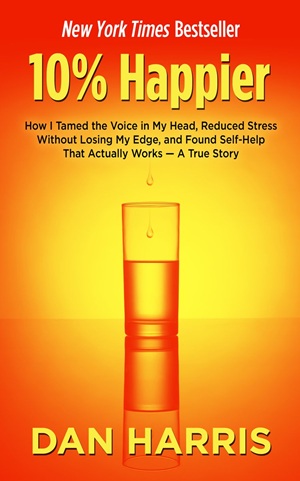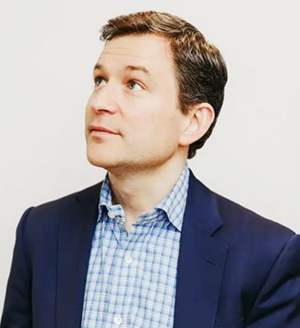Dec 19, 2025
Dec 19, 2025
10% Happier by Dan Harris
 The title of this book gives an impression of it being a self-help category of a book. It is actually so, but it is also more than that because it is of autobiographical nature. The author Dan Harris has shared his deep personal experiences which resulted in the conversion of the author from skeptic to an ardent proponent of meditation. The title of the book comes from the outcome of the meditation that the author experienced during the course of his exploration.
The title of this book gives an impression of it being a self-help category of a book. It is actually so, but it is also more than that because it is of autobiographical nature. The author Dan Harris has shared his deep personal experiences which resulted in the conversion of the author from skeptic to an ardent proponent of meditation. The title of the book comes from the outcome of the meditation that the author experienced during the course of his exploration.
In the 1st chapter the author shares that 5.019 million people saw him lose his mind on their television sets on 07 June 2004, on the set of Good Morning America. Then Harris takes us on a flashback tour to start off his career on March 13th, 2000, his first day at the ABC News as a 28 year old intern. Next in July 2003 he was given a verdict by the psychologist that he had depression. The psychologist prescribed anti-depressants. However, he had started self-medicating on drugs. It was the cause of his meltdown on live TV on the show. He called his mom afterwards, as he says, “She knew exactly what was up.” Now a new psychologist named Dr. Andrew Brotman was found for him by his folks – both Doctors. Dr. Brotman explained to him that the frequent use of cocaine increases adrenaline in the brain, which dramatically ups the odds of having a panic attack. Sitting in Dr. Brotman’s office Harris says, “the sheer enormity of my mindlessness started to sink in.”
In Chapter 2, titled Unchurched, Harris provides details of his filing reports on Christian Reality TV shows, Christian Rock Festivals, and many more including Christian financial advisors, Christian fitness clubs etc. Interestingly in one interview a big-time pastor Ted Haggard, was trash talking another major figure in Evangelism, which seemed little unchristian to him. Next Harris mentions the panic attacks that he faced about his on career being doomed. He moves on to describe how Ted Haggard, an evangelist, a family man of five children and the spiritual head of thousands was being accused for paying for sex as well as crystal meth. It is followed by his long and desperate attempts to connect with him. Nearly a year later, he heard back from him via email. A few months later he met Haggard in NY for an interview. In the interview Haggard apologized for his own behavior, which he characterized as vehement because of his own internal struggles.
 In Chapter 3, titled Genius or Lunatic we are introduced to Ekart Tolle, who wrote the book titled A New Earth, whom he refers to as Oprah approved self-help swami. Tolle agued in the book that, “we are governed by a voice in our heads. This voice is on a classless stream of thinking – most of it negative, repetitive, and self-reverential.” He also shared what he termed as the most powerful “Tollean” insight into ego, that it is obsessed with the past and the future, at the expense of the present. On reading the book he came up with the idea of interviewing Tolle, who was going to be in Toronto. Harris with his team was granted a one hour audience. In the interview he asked Tolle how to stop thinking. Tolle’s response was, “You create little spaces in your daily life where you are aware but not thinking.” Harris concludes the Chapter that he had opened “a window in enfeebling clamor of the ego” in him.
In Chapter 3, titled Genius or Lunatic we are introduced to Ekart Tolle, who wrote the book titled A New Earth, whom he refers to as Oprah approved self-help swami. Tolle agued in the book that, “we are governed by a voice in our heads. This voice is on a classless stream of thinking – most of it negative, repetitive, and self-reverential.” He also shared what he termed as the most powerful “Tollean” insight into ego, that it is obsessed with the past and the future, at the expense of the present. On reading the book he came up with the idea of interviewing Tolle, who was going to be in Toronto. Harris with his team was granted a one hour audience. In the interview he asked Tolle how to stop thinking. Tolle’s response was, “You create little spaces in your daily life where you are aware but not thinking.” Harris concludes the Chapter that he had opened “a window in enfeebling clamor of the ego” in him.
In Chapter 4, we are introduced to Deepak Chopra six weeks after meeting with Tolle. Here he shares Chopra insisted that he was permanently present. Later he visited Chopra Center in NY, with Chopra himself giving him the tour. Harris’s impression is beautifully strung in the rap words of Jay Z; “I’m not a businessman…..I am business, man.” He found Chopra equally interesting and incomprehensible as he found Tolle.
“The Jew-Bu” is the title of Chapter 5, where we are introduced to Dr. Mark Epstein. For the unacquainted with the term, it means one with Jewish background practicing Buddhism. Epstein in his writings made it clear that to derive benefit from Buddhism, test drive the material. Then he shares information on “impermanence” i.e. nothing lasts – including us. We suffer because we get attached to people and possessions that ultimately evaporate. The route to true happiness was to achieve visceral understanding of impermanence. Then he mentions how his own consumption of Buddhist books was paying off. He made “deliberate effort to pause, look around, and savor things while they lasted.”
In Chapter 6, titled “The Power of Negative Thinking” Harris shares a profound observation that “in modern life our ancient fight-or-flight mechanism was being triggered too frequently, and was contributing to the epidemic of heart disease. He also shared how his practice of daily meditation radically altered his relationship with boredom. That experience for him was like anchoring himself in an underground aquifer of calm. Then he attended a session by Tara Brach, where she distilled the method of applying mindfulness in the acronym RAIN (Page 112) as:
R: Recognize – Acknowledge feelings.
A: Allow – Where you lean into it.
I: Investigate – Check how they affect the body.
N: Non-Identification – Realize that it is passing state of mind.
Next, we are introduced to another Jew-Bu named Joseph Goldstein who is going to hold a 10 day retreat in silence. In Chapter 7, titled Retreat we get a day by day, blow by blow account of the retreat. On Day Nine he discovered a huge constructive tool to tame the voice in his head was to ask if this is useful? He further elaborates it by clarifying that it is OK to worry, plot, and plan but only until it is not useful anymore.
In Chapter 8 titled “10% Happier”, Harris provides us with an answer to why he has taken on daily meditation. His simple yet profound answer is it makes me 10% Happier. This becomes the title of the book under review. We are informed that if we made a 10% return on our financial investments it will be huge, but here he was getting a 10% return on his time investment right in the beginning. He shares that the practice is allowing him to step back to watch it all happen, nano seconds at a time, and through the process it takes some of the fangs out of it. The title of Chapter 9 is, “The New Caffeine” and as we can guess we are exposed to new scientific research into meditation benefits. He then shares how Marturano, Corporate Secretary for General Mills who discovered meditation a few years earlier, advised how to fight info-blitzkrieg as:
In Chapter 10, he details about his meeting with Dalai Lama, at the conclusion of Emory Conference research where the scientists had presented their research on the effects of meditation. He found Dalai Lama to be more reasonable than either Eckhart Tolle or Deepak Chopra. At the end of the interview Dalai Lama advised him to practice compassion. Here he also shared that findings of Emory research that meditation released significantly lower doses of stress hormones called Cortisol. He added from his own reading about compassion that “a way to build the compassion muscle is the same way as regular meditation build the mindfulness muscle.” He concludes the book with Chapter 11, titled Hide the Zen, where he shared a ten-point list for reorienting his internal life, by mitigating the noxious tendencies of his mind and juicing up the compassion circuitry with a name of “The Way of the Warrior” for it.
This book shines a spotlight on the benefits of meditation from personal history as well as backup from scientific research. Because of its autobiographical nature it is an interesting read. If you are considering meditation to be part of daily life, do read it to understand what is involved.
26-Jul-2025
More by : Bhupinder Singh

|
Bhupinder , Your review of this book is in self an eye opener which raised my interest to reread this book. It is also a time when I have been gathering information on meditation from people of different discipline. I will surely read this book . Hope to discuss with you in the future |

|
Very nicely narrated the book and the content & themes of the book-Meditation and Tolle & Dalai Lama‘s views. Thanks for introducung to this valuable ’‘10% Happyer ’‘ book. |

|
Interesting article. Meditation is everything in life but difficult to be disciplined:( |